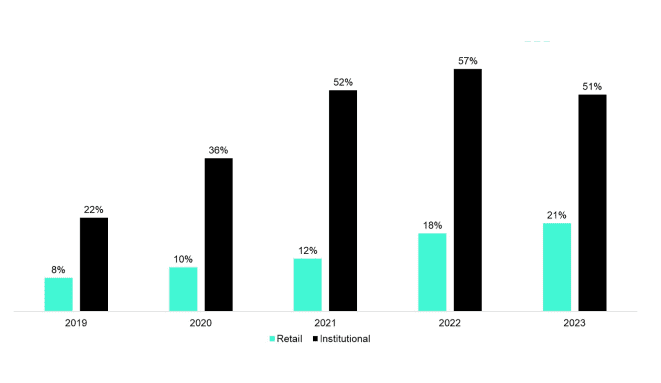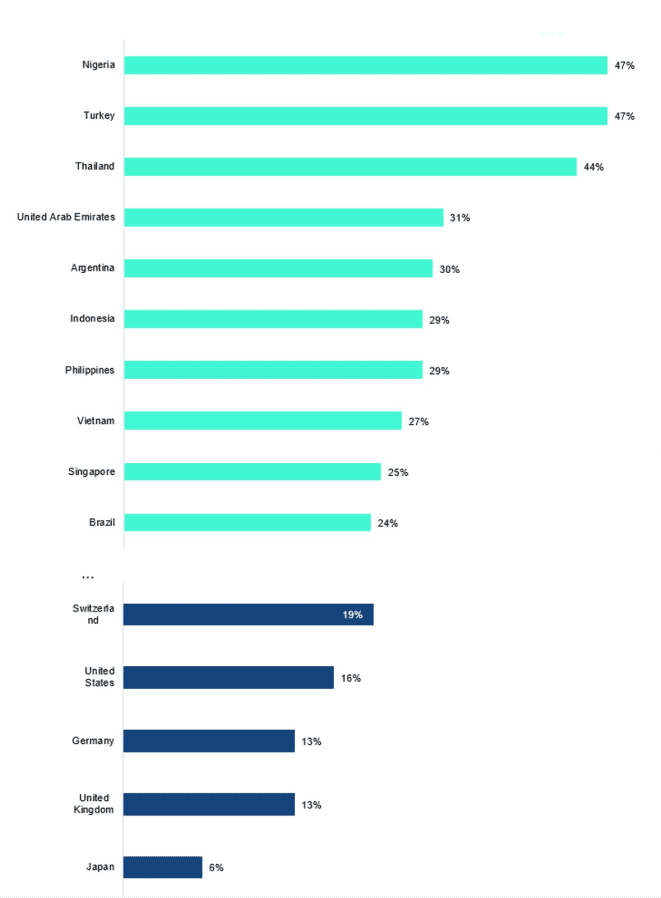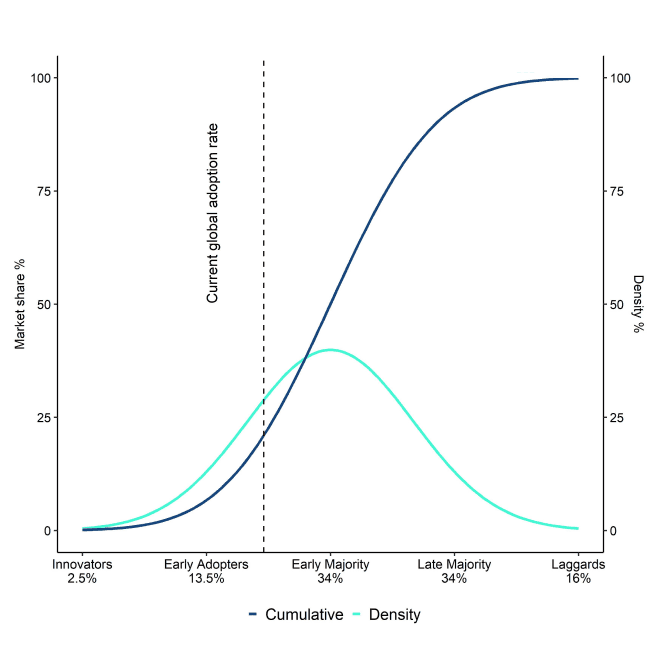- Global crypto asset adoption rates are significantly higher than previously estimated.
- The data generally suggest that both the US and Europe may be at the cusp of mass retail adoption – a situation often referred to as “Hyperbitcoinization” in the context of Bitcoin.
- Chances are that the growth of adoption will surprise to the upside due to the fact that we are most likely at the inflection point from "Early Adopters" to "Early Majority".

Trump recently made a public statement implying that 50 million Americans already held "crypto". The most recent surveys among US consumers seem to support this number.
It is no surprise that cryptoassets have become a major topic during the US presidential election as the parties have become increasingly aware that cryptoasset users could play a significant role at the ballot.
Both Trump and Robert Kennedy Jr. are scheduled to deliver a pro-Bitcoin speech at the upcoming Bitcoin conference in Nashville over the weekend.
It seems as if cryptoasset users are not a small minority anymore that can be ignored. Here are some recent US bitcoin and crypto adoption surveys for comparison (% of total population in brackets):
- Security.org: 93 mn (28%)
- Unchained: 86 mn (26%)
- Statista: 53.6 mn (16%)
- Morning Consult: 44.2 mn (13%)
- Finder: 38.4 mn (11%)
In general, cryptoasset adoption has been on the rise globally.
A recent global survey among institutional investors conducted by Fidelity even implies that 51% of surveyed institutional investors have already invested into cryptoassets such as Bitcoin.
Another recent consumer survey by Statista implies that approximately every 5th person (21%) worldwide has already invested into cryptoassets.

However, it's important to highlight that among the top 10 regions with the highest adoption rates, 8 regions are developing countries. So, cryptoasset adoption rates are even significantly higher among developing countries than in developed countries that often suffer from chronically high inflation rates and weak domestic currencies.

That being said, the data generally suggest that both the US and Europe may be at the cusp of mass retail adoption – a situation often referred to as “Hyperbitcoinization” in the context of Bitcoin.
The reason is that technological adoption in general tends to accelerate at the threshold from the so-called “early adopters” to the “early majority” which is around 16% adoption rate based on the model of technological adoption famously put forth by Rogers (1962).
Global adoption rates are already at 21% while adoption rates in the US and Europe are at around 16% and 14%, respectively. So, there is a strong case for an acceleration of adoption rates in these regions and globally over the coming years.

Recent political developments in the US also imply that Bitcoin and cryptoassets are gradually becoming mainstream.
Trump has recently endorsed domestic Bitcoin mining in the US and both Democrats and Republicans have started accepting crypto payments for campaign financing. The big success of the spot Bitcoin ETFs this year and the fact that additional types of spot crypto ETFs are being launched marks a significant shift in sentiment among US regulators in this regard.
In short, chances are that the growth of adoption will surprise to the upside due to the fact that we are most-likely at the inflection point from "Early Adopters" to "Early Majority".
Bottom Line
- Global crypto asset adoption rates are significantly higher than previously estimated.
- The data generally suggest that both the US and Europe may be at the cusp of mass retail adoption – a situation often referred to as “Hyperbitcoinization” in the context of Bitcoin.
- Chances are that the growth of adoption will surprise to the upside due to the fact that we are most likely at the inflection point from "Early Adopters" to "Early Majority".
AVVISO IMPORTANTE:
Questo articolo non costituisce consulenza finanziaria, né rappresenta un'offerta o un invito all'acquisto di prodotti finanziari. Questo articolo è solo a scopo informativo generale, e non vi è alcuna assicurazione o garanzia esplicita o implicita sulla correttezza, accuratezza, completezza o correttezza di questo articolo o delle opinioni in esso contenute. Si consiglia di non fare affidamento sulla correttezza, accuratezza, completezza o correttezza di questo articolo o delle opinioni in esso contenute. Si prega di notare che questo articolo non costituisce né consulenza finanziaria né un'offerta o un invito all'acquisizione di prodotti finanziari o criptovalute.
PRIMA DI INVESTIRE IN CRYPTO ETP, GLI INVESTITORI POTENZIALI DOVREBBERO CONSIDERARE QUANTO SEGUE:
Gli investitori potenziali dovrebbero cercare consulenza indipendente e prendere in considerazione le informazioni rilevanti contenute nel prospetto base e nelle condizioni finali degli ETP, in particolare i fattori di rischio menzionati in essi. Il capitale investito è a rischio, e le perdite fino all'importo investito sono possibili. Il prodotto è soggetto a un rischio controparte intrinseco nei confronti dell'emittente degli ETP e può subire perdite fino a una perdita totale se l'emittente non adempie ai suoi obblighi contrattuali. La struttura legale degli ETP è equivalente a quella di un titolo di debito. Gli ETP sono trattati come altri strumenti finanziari.
